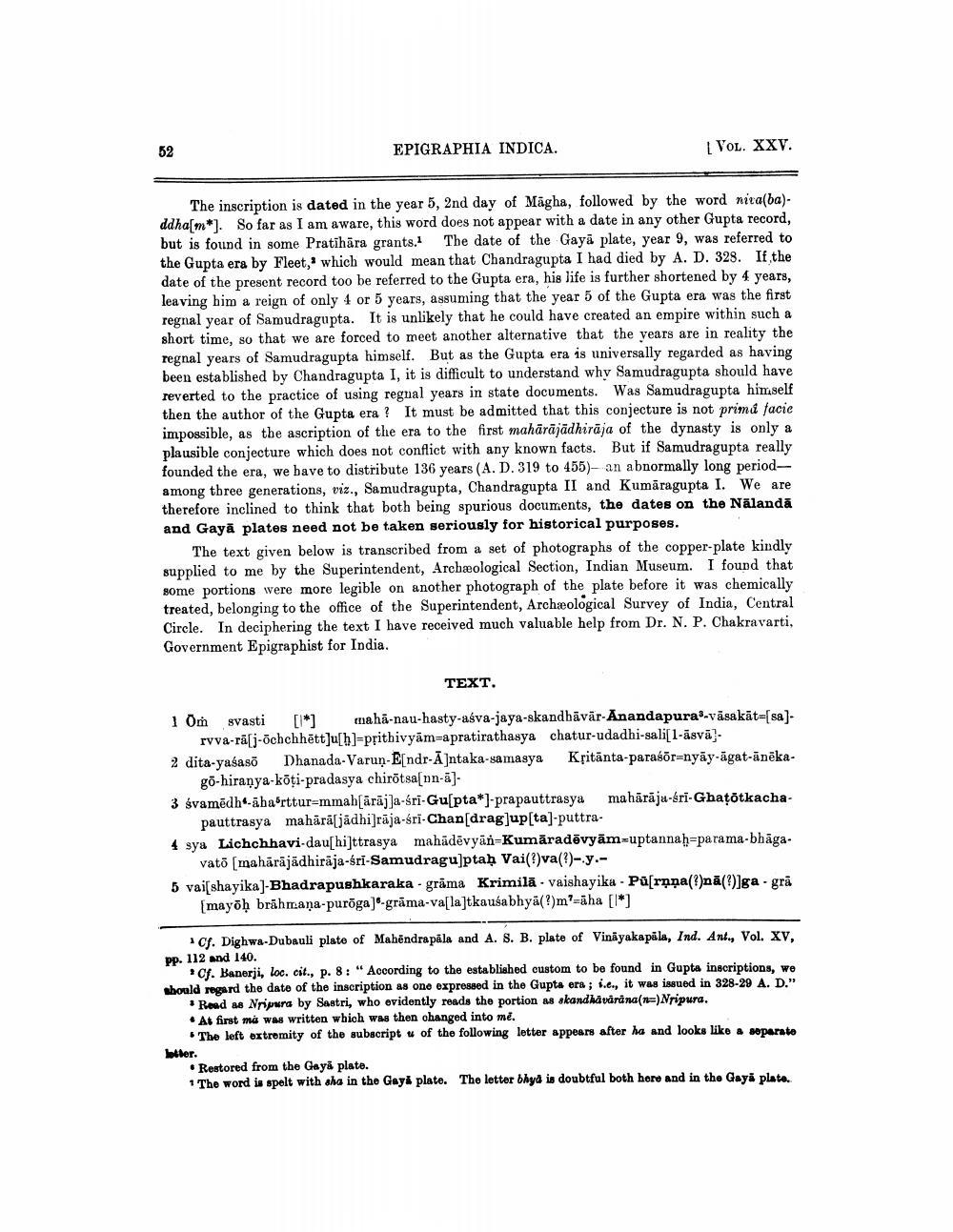________________
EPIGRAPHIA INDICA.
| VOL. XXV.
The inscription is dated in the year 5, 2nd day of Māgha, followed by the word nita(ba)ddha[m*). So far as I am aware, this word does not appear with a date in any other Gupta record, but is found in some Pratihāra grants. The date of the Gayā plate, year 9, was referred to the Gupta era by Fleet, which would mean that Chandragupta I had died by A. D. 328. If the date of the present record too be referred to the Gupta era, his life is further shortened by 4 years, leaving him a reign of only 4 or 5 years, assuming that the year 5 of the Gupta era was the first regnal year of Samudragupta. It is unlikely that he could have created an empire within such a short time, so that we are forced to meet another alternative that the years are in reality the regnal years of Samudragupta himself. But as the Gupta era is universally regarded as having been established by Chandragupta I, it is difficult to understand why Samudragupta should have reverted to the practice of using regual years in state documents. Was Samudragupta himself then the author of the Gupta era ? It must be admitted that this conjecture is not primú facie impossible, as the ascription of the era to the first mahārājādhiraja of the dynasty is only a plausible conjecture which does not conflict with any known facts. But if Samudragupta really founded the era, we bave to distribute 136 years (A.D. 319 to 455)- an abnormally long periodamong three generations, viz., Samudragupta, Chandragupta II and Kumāragupta I. We are therefore inclined to think that both being spurious documents, the dates on the Nālandā and Gayā plates need not be taken seriously for historical purposes.
The text given below is transcribed from a set of photographs of the copper-plate kindly supplied to me by the Superintendent, Archæological Section, Indian Museum. I found that some portions were more legible on another photograph of the plate before it was chemically treated, belonging to the office of the Superintendent, Archäological Survey of India, Central Circle. In deciphering the text I have received much valuable help from Dr. N. P. Chakravarti, Government Epigraphist for India.
TEXT.
1 Om svasti [*1 mahā-nau-hasty-aśva-jaya-skandbāvär- Anandapura -väsakāt=[sal
ryva-rā[j-ochchhētt]u[b]=prithivyām=apratirathasya chatur-udadhi-salis 1-āsvā}. 2 dita-yasaso Dhanada-Varun-E[ndr-A]ntaka-samasya Kritānta-paraśõr=nyāy-agat-ānēka
go-hiranya-kõți-pradasya chirotsa[ nn-ā)3 svamēdh-abaörttur=mmah[ārāj]a-sri-Gu[pta* -prapauttrasya mahārāja-sri-Ghatotkacha
pauttrasya mahārāsjadhi]rāja-sri-Chan[drag]up[ta)-puttra4 sya Lichchhavi-dau[hi]ttrasya mahādēvyān-Kumāradēvyām=uptannah=para ma-bhāga
vato (mahārājādhiraja-sri-Samudragu]ptaḥ Vai(?)va(?)- y.5 vaisshayika)-Bhadrapushkaraka - gräma Krimilā - vaishayika - Pū[rņņa(4)na(Olga - grā [mayoh brāhmaṇa-puroga)-grāma-vallaltkausabhyä(?)
m aha [1*1
*Cf. Dighwa-Dubauli plate of Mahendrapala and A. S. B. plate of Vinayakapăla, Ind. Ant., Vol. xv, Pp. 112 and 140.
C1. Banerji, loc. cit., p. 8: "According to the established custom to be found in Gupta inscriptions, we should regard the date of the inscription as one expressed in the Gupta era ; i.e., it was issued in 328-29 A. D."
* Read as Nripura by Sastri, who evidently reads the portion as skandhavarana(n=)Nripura. • At first me was written which was then changed into me.
• The left extremity of the subscript of the following letter appears after ha and looks like a separato botter.
• Restored from the Gaya plate. 1 The word is spelt with sha in the Gayi plate. The letter bhyd is doubtful both hore and in the Gaya plate.




